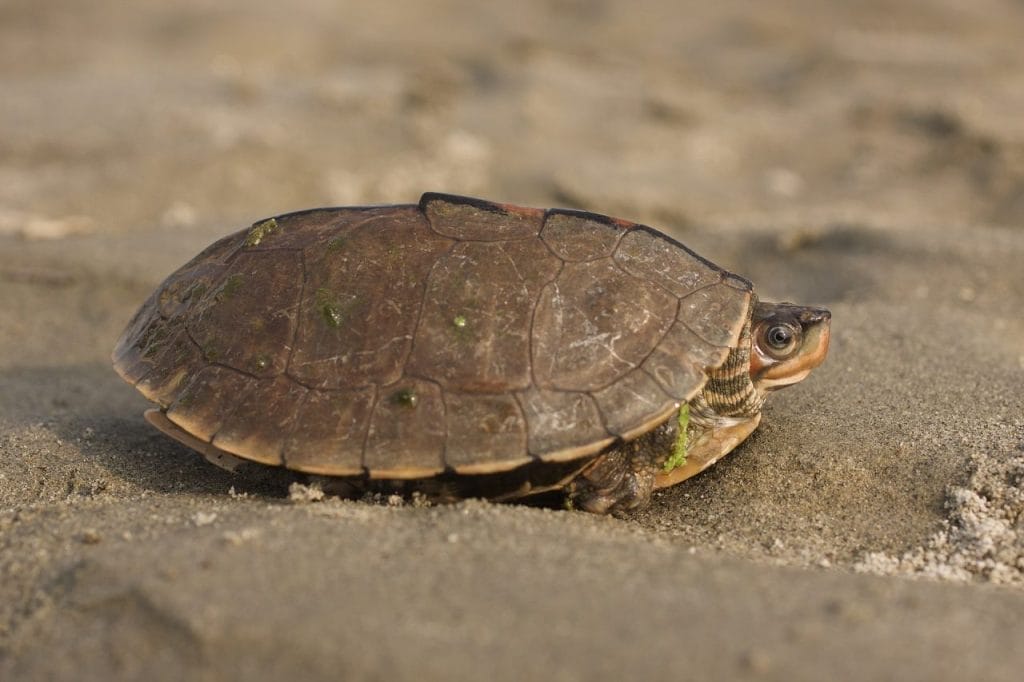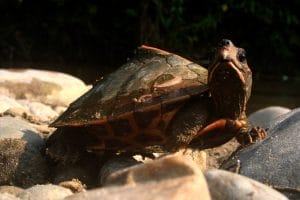Pangshura smithii (Brown roofed turtle)
Home > Turtle Database > Pangshura smithii (Brown roofed turtle)

Pangshura smithii, also known as the brown roofed turtle, is a small to medium-sized freshwater turtle found across parts of South Asia. Known for the dome-shaped shell with subtle keels, this turtle lives in rivers and ponds and is often spotted basking near water.
Native To These Regions
Assam (India), Bangladesh, Bihar (India), Haryana (India), Madhya Pradesh (India), Nepal, Odisha (India), Punjab (India), Punjab (Pakistan), Rajasthan (India), Sindh (Pakistan), Uttar Pradesh (India), West Bengal (India)Native Turtle Species Map – Find Turtles by Region
Scientific Classification
Kingdom: Animalia
Phylum: Chordata
Class: Reptilia
Order: Testudines
Family: Geoemydidae
Genus: Pangshura
Species: Pangshura smithii
Common Names
Brown roofed turtle
Smith’s roofed turtle
This Hilarious Turtle Book Might Know Your Pet Better Than You Do
Let’s be real—most turtle care guides feel like reading a textbook written by a sleep-deprived zookeeper.
This one’s not that.
Told from the snarky point of view of a grumpy, judgmental turtle, 21 Turtle Truths You’ll Never Read in a Care Guide is packed with sarcasm, sass, and surprisingly useful insights.
And hey—you don’t have to commit to the whole thing just yet.
Grab 2 free truths from the ebook and get a taste of what your turtle really thinks about your setup, your food choices, and that weird plastic palm tree.
It’s funny, it’s honest, and if you’ve ever owned a turtle who glares at you like you’re the problem—you’ll feel seen.
Identification
Description
The shell is oval and has a brown to olive color with faint lines or streaks. It has three slight keels on the carapace, giving it a roofed look. The plastron is yellow with dark patches. The head is narrow, and the limbs are scaled.
Sexual Dimorphism
Males are smaller with longer, thicker tails. Females grow larger and have shorter tails. Males often have a concave plastron, while females have a flatter one.
Check more turtles from the Pangshura genus
Native Origin and Distribution
Geographical Range
Found across the Indian subcontinent, mainly in northern and central India, Pakistan, Nepal, and Bangladesh.
Preferred Habitat
They live in slow-moving freshwater habitats like rivers, ponds, lakes, and marshes. These turtles prefer places with plenty of basking spots and soft bottoms for burrowing.
Behavior
Feeding Habits
They are omnivorous. Their diet includes aquatic plants, small invertebrates, and carrion. Juveniles eat more protein-rich items, while adults lean more toward plant matter.
Predators
Birds of prey, large fish, snakes, and some mammals prey on hatchlings. Adults are less targeted but may fall victim to humans or large animals.
Reproduction
Breeding Season
Breeding usually occurs during the dry season, from October to March.
Reproductive Method
Females lay 3–10 eggs per clutch in sandy or soft soil near the water. Incubation lasts around 70–90 days, depending on temperature.
Conservation
Extinction Status
Listed as Near Threatened by the IUCN, but local populations may be declining.
Threats
Major threats include habitat destruction, pollution, water diversion, and capture for the pet trade or local consumption.
Conservation Measures
Some protected areas cover their natural range. Education, habitat preservation, and stricter law enforcement are key steps being pushed forward.
Economic Importance
Not widely used commercially, but occasionally caught for local consumption or traditional uses. They may also appear in local pet markets.
Interesting Facts
The “roofed” name comes from the shape of the shell, which slopes like a roof.
They’re known to bask for hours and are quick to dive into the water at the slightest disturbance.
Despite being a freshwater species, they can tolerate slight salinity in water.

About Author
Muntaseer Rahman started keeping pet turtles back in 2013. He also owns the largest Turtle & Tortoise Facebook community in Bangladesh. These days he is mostly active on Facebook.














